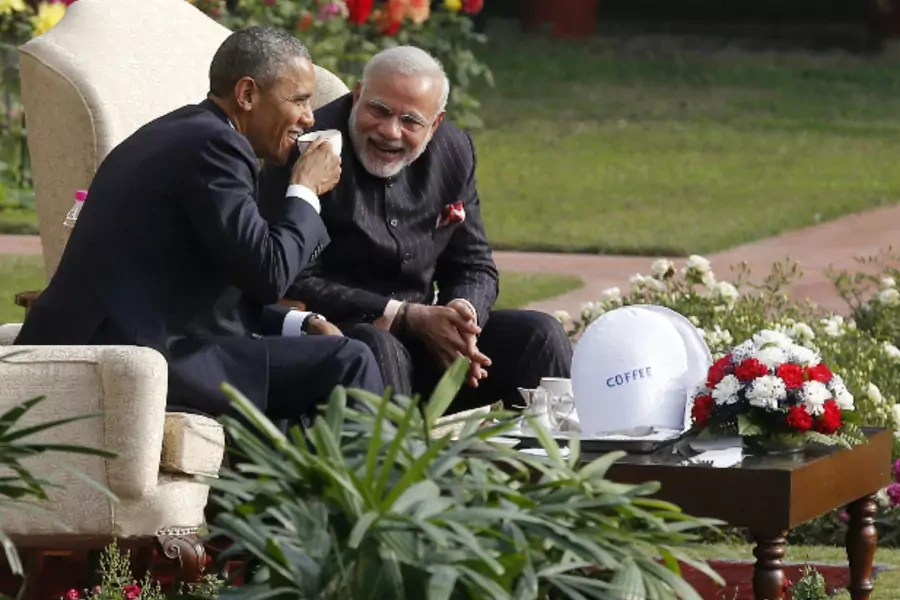Next Steps with India (चलें साथ साथ कहां ?)

By most estimates, President Barack Obama had a good visit to India last week. The atmosphere was spectacular—how could it not be, with India’s Republic Day parade the backdrop—and the apparent warmth between Prime Minister Narendra Modi and President Obama was visible from the big airport bear hug, chuckles over tea, and first-name informality (well, at least on Modi’s part) on a joint radio program.
It’s true that no “big announcement” came out of the visit akin to the dramatic 2005 unveiling of the U.S.-India civil nuclear initiative. But in my view, that’s too high a threshold for every summit meeting to clear. The Republic Day Modi-Obama meeting resulted in some tangible outcomes, and some new markers for how and where India and the United States will take steps together. Here’s my shortlist of what to watch for next.
More on:
1. Further U.S.-India cooperation on clean energy: Some climate-focused observers held out hope that the Republic Day summit might result in a U.S.-India announcement on agreed emissions reductions, like the agreement between the United States and China in 2014. That hope ignored numerous direct public statements from Indian government officials to the contrary. India has for years rejected binding emissions targets due to a concern for equity (despite being the world’s third largest emitter, India still has low per capita emissions) and a focus on economic growth before moving to cap emissions.
On the other hand, building on the strong science and technology capacity in India, and the country’s focus on innovation (especially frugal innovation), clean energy research and innovative ways to get clean energy to power grids at scale has become a strong area of U.S.-India partnership. It was the one area where Obama announced new financing, for example, and a new clean energy finance task force will launch shortly. It’s also a subject Modi feels passionately about. So expect to see more in this productive “quiet big idea” between the United States and India.
2. U.S.-India cooperation across the Indian Ocean and Asia Pacific: Every major summit results in long “joint statements” containing the bureaucratic version of accounting for all the activity of previous months (or years). The Republic Day summit joint statement numbers eleven pages of small font text and many lists of what’s been done. Unusually, this summit resulted in two additional documents. One, the “Delhi Declaration of Friendship” appears to lift Washington and New Delhi up a notch from “strategic partners” to “friends.” (The other “friendship” document, of course, was the famous 1971 Indo-Soviet Treaty of Peace, Friendship and Cooperation.) The second deserves close reading: the “Joint Strategic Vision for the Asia-Pacific and Indian Ocean Region.” It elevates diplomatic positions previously made at lower levels to a leadership vision document—and important for that reason. The just-released U.S. National Security Strategy similarly refers to a “strategic convergence with India’s Act East policy and our continued implementation of the rebalance to Asia and the Pacific.” Expect more on this front.
3. India and the Asia Pacific Economic Cooperation forum (APEC): Since the 2010 moratorium on new members was lifted, APEC has not moved to induct a single new member—not even a huge economy like India. And the United States has been silent on India’s desire for membership. Until the Republic Day summit. The “Joint Strategic Vision” statement contained a line that “welcomes India’s interest” in joining APEC; it’s the first formal statement Washington has ever made indicating measured support for India in APEC. Now I realize this “welcome” of interest is not a direct and unequivocal indication of support. That’s the next place I’d recommend for U.S. action: clear and unambiguous support for Indian membership, and a plan to get India in APEC by the November summit.
4. Commercializing the U.S.-India civil nuclear agreement: Obama and Modi announced a “breakthrough” in the long-pending matter of how private companies, unprotected by a sovereign guarantee, could operate in India’s civil nuclear energy market under current Indian law. The Republic Day summit produced a statement that a resolution has been reached between the two governments. The next step, of course, will be whether it creates a solid and workable business environment, and only the companies involved will be able to make that assessment.
More on:
For a longer discussion of these issues and more, the Council on Foreign Relations hosted a panel discussion on February 4 covering the summit and next opportunities for the United States and India. It’s worth a look.
Follow me on Twitter: @AyresAlyssa
 Online Store
Online Store